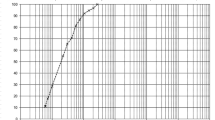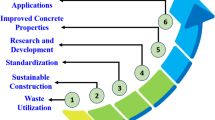Abstract
Most of the materials used in landfill liners are not based on the local soil conditions which increases the cost of landfill construction. It is essential to develop a composite mix based on local soil that fulfills the design parameters of the municipal solid waste (MSW) landfill at a reasonable cost as per USEPA 1989 guidelines. The current study investigates the use of local soil, fly ash, and bentonite mixtures to obtain an optimum composite mix with specific properties for landfill liners. The experimental investigation was conducted on different proportions of local soil-bentonite-fly ash mixes to evaluate the optimum mix proportion for liner materials. The curing period of different mixes is also considered. The geotechnical properties like liquid limit (LL), free swell index (FSI), and optimum moisture content (OMC) increased whereas the maximum dry density (MDD) and permeability decreased with an increase in bentonite content up to 20% with soil. It was also observed that fly ash mixed with soil in proportion (80:20) meets the optimum range of landfill liner properties. And, the composite mix comprised of soil–bentonite–fly ash in proportion (65:15:20) directs toward the optimum design parameters of landfill liner. These mixes were compacted at OMC and MDD satisfying plasticity (i.e., LL ≥ 20% and plasticity index, PI ≥ 7%) and permeability criteria (k ≤ 1 × 10−7 cm/s) as well as unconfined compressive strength criteria. Moreover, the scanning electron microscopy of local soil–bentonite–fly ash mixes was investigated for the optimum mixes for a comparative assessment of results.























Similar content being viewed by others
References
Daniel D E 1984 Predicting hydraulic conductivity of clay liners. Journal of Geotechnical Engineering. 110(2): 285–300
Central Electricity Authority 2022 Report on fly ash generation at coal/lignite based thermal power stations and its utilization in the country for the year 2021–22. Central Electricity Authority, New Delhi
Nhan C T, Graydon J W and Kirk D W 1996 Utilizing coal fly ash as a landfill barrier material. Waste Management. 16(7): 587–595
Gray D H and Lin Y K 1972 Engineering properties of compacted fly ash. Journal of the Soil Mechanics and Foundations Division. 98(4): 361–380
Joshi R C and Lohtia R P 1997 Fly Ash in Concrete Production. Properties and Uses. In: Advances in Concrete Technology Vol.2. Gordon and Breach Science Publishers
Ghani S, Kumari S, Choudhary A K and Jha J N 2021 Experimental and computational response of strip footing resting on prestressed geotextile-reinforced industrial waste. Innovative Infrastructure Solutions. 6: 1–15
Kumar A, Kumari S and Sharma R K 2021 Strength Enhancement of Clayey Soil Using Cement Kiln Dust and Recron Fiber. In: Proceedings of the Indian Geotechnical Conference 2019: IGC-2019 Volume III pp. 141–148
Koch D 2002 Bentonites as a basic material for technical base liners and site encapsulation cut-off walls. Applied Clay Science. 21(1–2): 1–11
Edil T B, Berthouex P M and Vesperman K D 1987 Fly ash as a potential waste liner. In: Geotechnical Practice for Waste Disposal'87: 447–461
Standard A S T M C618-08a 2008 standard specification for coal fly ash and raw or calcined natural pozzolan for use in Concrete. Annual Book of ASTM standards
Joshi R C 2000 Soil improvement using fly ash. In: Proceedings of Indian Geotechnical Conference-2000 Indian Geotechnical Society. 5–10
USEPA 1989 Requirements for Hazardous Waste Landfill Design, Construction, and Closure. seminar publication. United States Environmental Protection Agency. Cincinnati. Report No. 625/4–89/022: 1–127
Qian X, Koerner R M and Gray D 2002 Geotechnical Aspects of Landfill Design and Construction. Prentice Hall, New Jersey, USA
Daniel D E and Wu Y K 1993 Compacted clay liners and covers for arid sites. Journal of Geotechnical Engineering. 119(2): 223–237
Rowe R K, Booker J R and Quigley R M 1995 Clayey barrier systems for waste disposal facilities. E & FN Spon London, U.K
Oscarson D W, Dixon D A and Hume H B 1996 Mass transport through defected bentonite plugs. Applied Clay Science. 11: 127–142
Kenney T C, Veen W V, Swallow M A and Sungaila M A 1992 Hydraulic conductivity of compacted bentonite–sand mixtures. Canadian Geotechnical Journal. 29(3): 364–374
Kumar R and Kumari S 2023 Geotechnical properties of materials used in landfill clay liner: A critical review. Sādhanā. 48(2): 64
Sachdev D R and Amdurer M 1985 Fly Ash as a Waste Pile Liner Material Feasibility Study Report no. EP82-84. Empire State Electric Energy Research Corporation
Vesperman K D, Edil R B and Berthouex P M 1985 Permeability of Fly Ash and Fly Ash Sand Mixtures In: Hydraulic Barriers in Soil and Rock, American Standard of Testing and Materials. Philadelphia, Pa. STP 874: 289–298
Alla V, Sasmal S K, Behera R N and Patra C 2017 Development of alternate liner material by blending fly ash, local soil and bentonite. IIT Guwahati, India: Indian Geotechnical Conference 2017
Joshi R C, Hettiaratchi J P A and Achari G 1994 Properties of modified Alberta fly ash in relation to utilization in waste management applications. Canadian Journal of Civil Engineering. 21(3): 419–426
Morettí C J and Henke K R 1987 Waste management Final report to the US Department, of Energy. University of North Dakota Energy Research Center. Grand Forks North Dakota
Ghani S and Kumari S 2022 Consumption of Industrial Waste in Sustainable Development of Clean and Environmentally Friendly City Near an Industrial Area. Facets of a Smart City: Computational and Experimental Techniques for Sustainable Urban Development. 103
Roy A, Eaton H C, Cartledge F K and Tittlebaum M E 1991 Solidification/stabilization of a heavy metal sludge by a Portland cement/fly ash binding mixture. Hazardous waste and Hazardous materials. 8(1): 33–41
Sharma A K and Sivapullaiah P V 2016 Ground granulated blast furnace slag amended fly ash as an expansive soil stabilizer. Soils and Foundations. 56(2): 205–212
Kumar A, Kumari S and Sharma R K 2016 Influence of use of additives on engineering properties of clayey soil. In: Proceedings of National conference: Civil Engineering Conference-Innovation for Sustainability CEC
Banerjee K, Cheremisinoff P N and Cheng S L 1997 Adsorption kinetics of o-xylene by flyash. Water Research. 31(2): 249–261
Li L 1996 The 4th Environ. Engr Specialty Conf. Edmonton, Alberta, Canada. CSCE Engineering Material Div. Special Publication. 191–199
Lagrega M D, Buckingham P L and Evan J C 1994 Hazardous Waste Management, McGraw Hills Inc. ISBN13: 978–1577666936
Bowders J J, Usmen M A and Gidley J S 1987 Stabilized fly ash for use as low-permeability barriers. In: Geotechnical Practice for Waste Disposal'87: 320–333
Toth P S, Chan H T and Cragg C B 1988 Coal ash as structural fill, with special reference to Ontario experience. Canadian Geotechnical Journal 25(4): 694–704
McLaren R J, and DiGioia A M 1987 The typical engineering properties of fly ash. In: Geotechnical Practice for Waste Disposal'87: 683–697
Prashanth J P, Sivapullaiah P V and Sridharan A 2001 Pozzolanic fly ash as a hydraulic barrier in landfills. Engineering Geology. 60(1–4): 245–252
Bowders Jr J J, Gidley J S and Usmen M A 1990 Permeability and leachate characteristics of stabilized class F fly ash. Transportation Research Record. 1288
Rashid H M A, Sardar A and Ismail A 2021 Geotechnical characterization of bentonite-fly ash mixtures for their application as landfill liner in Pakistan. Arabian Journal of Geosciences. 14(14): 1307
Kantesaria N, Chandra P, and Sachan A 2021 Geotechnical behaviour of fly ash-bentonite mixture as a liner material. In: Proceedings of the Indian Geotechnical Conference 2019. IGC-2019 Volume II. 237–247
Olaoye R A, Afolayan O D, Oladeji V O and Sani R O 2019 Influence of bentonite on clayey soil as a landfill baseliner materials. In: IOP Conference Series: Materials Science and Engineering. 640(1): 012107
Phani Kumar B R and Sharma R S 2004 Effect of fly ash on engineering properties of expansive soils. Journal of Geotechnical and Geoenvironmental Engineering. 130(7): 764–767
Chalermyanont T and Arrykul S 2005 Compacted sand-bentonite mixtures for hydraulic containment liners. Songklanakarin J. Sci. Technol. 27(2): 313–323
Rosli N A, Aziz H A, Selamat M R and Lim L L P 2020 A mixture of sewage sludge and red gypsum as an alternative material for temporary landfill cover. Journal of Environmental Management. 263: 110420
Eberemu A O, Amadi A A and Osinubi K J 2013 The use of compacted tropical clay treated with rice husk ash as a suitable hydraulic barrier material in waste containment applications. Waste and Biomass Valorization. 4: 309–323
Okoro I J, Amadi A A and Alhassan M 2023 Hydraulic Conductivity Characteristics of Iron-Ore Tailings-Bentonite Mixtures Exposed to Landfill Leachate. Journal of Hazardous, Toxic and Radioactive Waste. 27(3): 04023014
Tastan E O, Edil T B, Benson C H and Aydilek A H 2011 Stabilization of organic soils with fly ash. Journal of Geotechnical and Geoenvironmental Engineering. 137(9): 819–833
Hauser V L, Weand B L and Gill M D 2001 Natural covers for landfills and buried waste. Journal of Environmental Engineering. 127(9): 768–775. https://doi.org/10.1061/(ASCE)0733-9372(2001)127:9(768)
United States Environmental Protection Agency USEPA 1988 Design, construction and evaluation on of clay liners for waste management facilities. In Technical Resource Document. Cincinnati. OH: Hazardous Waste Engineering Research Laboratory, Office of Research and Development. U.S. Environmental Protection Agency. EPA/530-SW- 86-007F, NTIS PB 86–184496
Das S K and Yudhbir, 2006 Geotechnical properties of low calcium and high calcium fly ash. Geotechnical and Geological Engineering. 24: 249–326
Joshi R C and Nagaraj T S 2021 Fly ash utilization for soil improvement. In: Environmental geotechnics and problematic soils and rocks. 15–24
Devarangadi M and Shankar M U 2021 Effect on engineering properties of ground granulated blast furnace slag admixed with laterite soil. cement and bentonite mixtures as a liner in landfill. Journal of Cleaner Production. 329: 129757
Devarangadi M 2019 Use of ground granulated blast furnace slag blended with bentonite and cement mixtures as a liner in a landfill to retain diesel oil contaminants. Journal of Environmental Chemical Engineering. 7(5): 103360
Zhang Y, Wang S, Zhang B, Hou D, Li H, Li L, Wang J and Lin C 2020 A preliminary investigation of the properties of potassium magnesium phosphate cement-based grouts mixed with fly ash, water glass and bentonite. Construction and Building Materials. 237: 117501
Author information
Authors and Affiliations
Corresponding author
Rights and permissions
Springer Nature or its licensor (e.g. a society or other partner) holds exclusive rights to this article under a publishing agreement with the author(s) or other rightsholder(s); author self-archiving of the accepted manuscript version of this article is solely governed by the terms of such publishing agreement and applicable law.
About this article
Cite this article
Kumar, R., Kumari, S. A feasibility study of fly ash and bentonite composite mix for assessing its suitability as landfill liner material. Sādhanā 49, 98 (2024). https://doi.org/10.1007/s12046-024-02450-x
Received:
Revised:
Accepted:
Published:
DOI: https://doi.org/10.1007/s12046-024-02450-x




